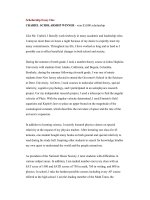CLASSIFICATION ESSAY
Bạn đang xem bản rút gọn của tài liệu. Xem và tải ngay bản đầy đủ của tài liệu tại đây (62.26 KB, 16 trang )
CLASSIFICATION ESSAY
Definition
• Classification means Division
Classification (n): the act or process of
putting people or things into a group or
class.
• Writing a classification essay
means dividing information into a
meaningful groups or categories
• The members in a group must share
similar characteristics and follows a
single and unifying principle
Function
• Arrange or organize information
into categories or groups.
• Break things down in order to
investigate them easily and
distinguish easily.
Classification organization
• Introduction
• The hook introduces the information
to be classified
• Background information includes a
general statement or statements that
give a broader picture of the subject
matter to be discussed
• The thesis statement tells what is
being classified and how it is being
organized.
Nowadays, many people evaluate others’ appearances or
behaviors to determine what kind of people they are. It is a
common mistake, isn’t it? Regardless of whether it is true or
not, this kind of stereotyping is very useful, and sometimes it
brings us some interesting things. People’s psychology is also
classified into three categories depending on the food they eat:
fast-food, vegetarian food, and home cooked food.
• Body
• The topic sentence clearly describes the
category in each paragraph and supports the
thesis statement.
• One category or group is described in each
paragraph. The information in each paragraph is
ordered logically (in order of importance or in
chronological order)
• The supporting details can be descriptions,
definitions, examples… that elaborate on the
topic sentence.
• The concluding sentence bring the idea of the
paragraph to close.
• Many people assume that “fast-food” people are usually
overweight, busy, and impatient. The first thing comes up
with people when they think of “fast-food” people is
about their weight. In fact, trans fat are commonly found
in fast-food, so people who eat it regularly consume a
high level of trans fat and calories, and then it triggers
many negative effects to their body, especially gaining
weight. Some others’ opinions believe that fast-food
people are very busy. That’s why they usually eat fastfood because it is rapidly severed in bags or cartons for
people’s convenience. Therefore, they are able to save
much time for other things. Moreover, this kind of people
is very impatient because of their hectic lives. They
cannot seat in an hour to wait for someone or working in
a short time without any signs of success. They think that
it waste too much time and then easily to give up. In the
same kind of stereotyping, people base on vegetarian
food to determine others.
• People think that vegetarians are usually skinny,
superstitious, and careful of their health. Actually,
vegetables contain a high proportion of vitamins, but in
contrast with fast-food, they generally have a small
proportion of protein and fat, so vegetarians are very
skinny. In addition, it is very common that people who
eat only vegetables tend to be superstitious. They
believe that not eating any kinds of meat means not
killing any animals. Therefore, they can accumulate the
good for their later generations, or they will be able to
get the greatest happiness after they die. Beside that,
many vegetarians assume that eating only vegetables
can protect them from illnesses and also be able to
keep their lives longer. In our world, especially in China
and Japan, there are a lot of very old people who are
still very strong and healthy have revealed that almost
food in their lives are vegetables. Similarly, home
cooked food is another thing to define people.
• Conclusion
• It restates the content of each
paragraph
• It may make a prediction, give
advice or make a general statement.
•
To sum up, people are classified into three main categories
basing on their regular food. Fast-food people would like a
hectic life, while “their own food” people prefer a leisure life,
and vegetarians tend to live a “holy” life. For me knowing what
kind of people they are is very useful to start a new
relationship with them or just to behave in the most
appropriate ways toward them, and then my life will probably
overwhelm with joys and happiness.
How to proceed
•
Prewriting:
+ Name the categories which you will classify.
+ Find out several examples and their properties of each
category.
•
Tips:
Don’t Mix Principles!
It’s confusing to have
overlapping bases for classification.
* For example: if you’re characterizing
cell phones by size, don’t include
classes such as “expensive” or “nice
looking.”
Exercise
•
Choose one item that doesn’t belong to the group
•
1. Shirts
a. Flannel
b. Cotton
c. Tuxedo
d. Denim
e. Silk
What is the
principle?
2. School subjects
a. Algebra
b. History
c. Geometry
d. Trigonometry
e. Calculus
What is the principle?
Complete the Categories
When you’re classifying, don’t
leave anyone or anything out.
Look for obvious missing
elements.
– Say the writing prompt is “What kind of
students are there in your math class?”
– Your answer: “Fast and slow learners.”
-> But what about the average learners?
After all, you need three categories!
Use Parallel Construction in the thesis statement
•
Notice that each categorical word is in the same grammatical
form
•
Organize your thesis statement with parallelism:
– Eg: “Most people respond in one of three
ways: eagerly, indifferently, or reluctantly.”
LANGUAGE FOCUS
• Establishing the Order of Important, Degree, and
Size -> make a logical order
The following expressions will help you rank objects or
ideas in order of importance, degree or size:
The most/greatest
The best
The largest
The maximum
The most significant
The most important
The second most/greatest
The second fastest
The next best
The second highest
The second largest
The least/ fewest
The slowest
The worst
The lowest
The smallest
The minimum
The least significant
The least important
- To show similarity or equality, use the same, almost the same, and
similar to.









